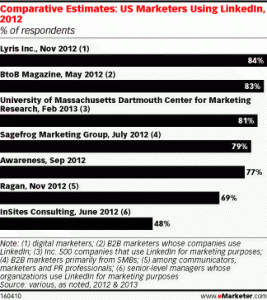Changes at LinkedIn Create New Marketing Opportunities
Stickiness remains a challenge
LinkedIn is a company undergoing massive transformation. It is moving from its roots as a business-oriented social network and becoming a business-to-business (B2B) content publishing platform, according to a new eMarketer report, “Marketing on LinkedIn: New Opportunities, but Old Issues Remain.”
With that change comes a variety of new ways companies can market and advertise, including native ads in the feed and PowerPoint-style ads using technology from SlideShare, which LinkedIn acquired last year.
The ad revenue picture for LinkedIn looks positive. eMarketer forecasts that worldwide ad revenues will reach $376 million in 2013, up 46.7% from last year.

However, usage trends have been mixed; this spring, ComScore reported that LinkedIn passed Twitter to become the second-largest social network in the world, ranked by unique visitors. LinkedIn’s internal data also shows that activity on the service has increased. However, comScore also reported that in the US, time spent on the site has been flat during the past year, an indication that LinkedIn’s new content offerings have not yet led to increased usage.
Changes are happening in nearly every corner of the business, from the back end to the front. LinkedIn has updated the computing infrastructure that supports the service and redesigned the user interface to showcase fresh content from around the internet as well as status updates from people in a user’s network. In addition, the company has bolstered its flagship recruiting business with new services aimed at securing the company’s position as the premier hiring resource. It has also developed tools for sales executives to help them connect with prospects and close deals.

LinkedIn is popular among marketers, particularly B2B marketers. A review of several studies—conducted primarily among B2B and small- and medium-sized business marketers in the US—indicates that in 2012, about 80% used LinkedIn for marketing.

LinkedIn is especially valued for the tools it offers across the marketing continuum. Many of its products are designed to support both branding and lead-generation goals. For example, sponsored groups help connect like-minded business professionals.
Lower-funnel products, such as self-serve ads and Sponsored InMail ads, allow companies to target messages to specific audiences and pay based on actions, such as clicks (for self-serve ads) or message delivery (for Sponsored InMails). The newest ad products, such as SlideShare Content Ads and Sponsored Updates, broaden the toolset that marketers can use to target the difficult-to-reach business audience.
For more details: eMarketer





 Posted On October 18 2025
Posted On October 18 2025